Conversational AI – Game Changer Talking Tech
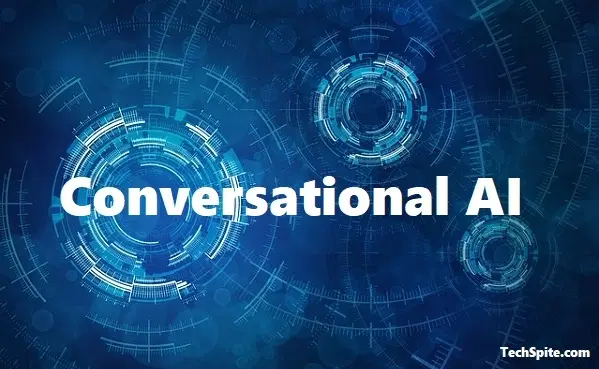

Have you ever chatted with a robot? If so, chances are you were interacting with conversational AI. This exciting technology is becoming more prevalent in our daily lives, as businesses and organizations use it to improve customer engagement, streamline operations, and provide better service.
This article will delve into the history of Conversational AI, from early chatbots to modern voice assistants. We will explore the technology behind it, including Natural Language Processing (NLP) and Speech Recognition. Moreover, we will discuss the recent advancements in Conversational AI, such as OpenAI’s GPT-3 and the latest version GPT-4, Google’s BERT, and Microsoft’s Turing Natural Language Generation. We will also examine its real-world applications, from healthcare and customer service to education and business. Finally, we will speculate on the future of Conversational AI and its impact on human-machine interaction, augmented intelligence, and the workforce.
After reading this article, you will have a comprehensive understanding of Conversational AI and its potential to shape the future of technology.
Let’s begin!
Conversational AI
Conversational AI is the technology that enables computers to communicate with humans in a natural language. It is also known as chatbots, virtual assistants, or voice assistants. Conversational AI can understand human language, interpret it, and respond like humans. This technology is revolutionizing how businesses interact with customers, making communication more efficient and effective.
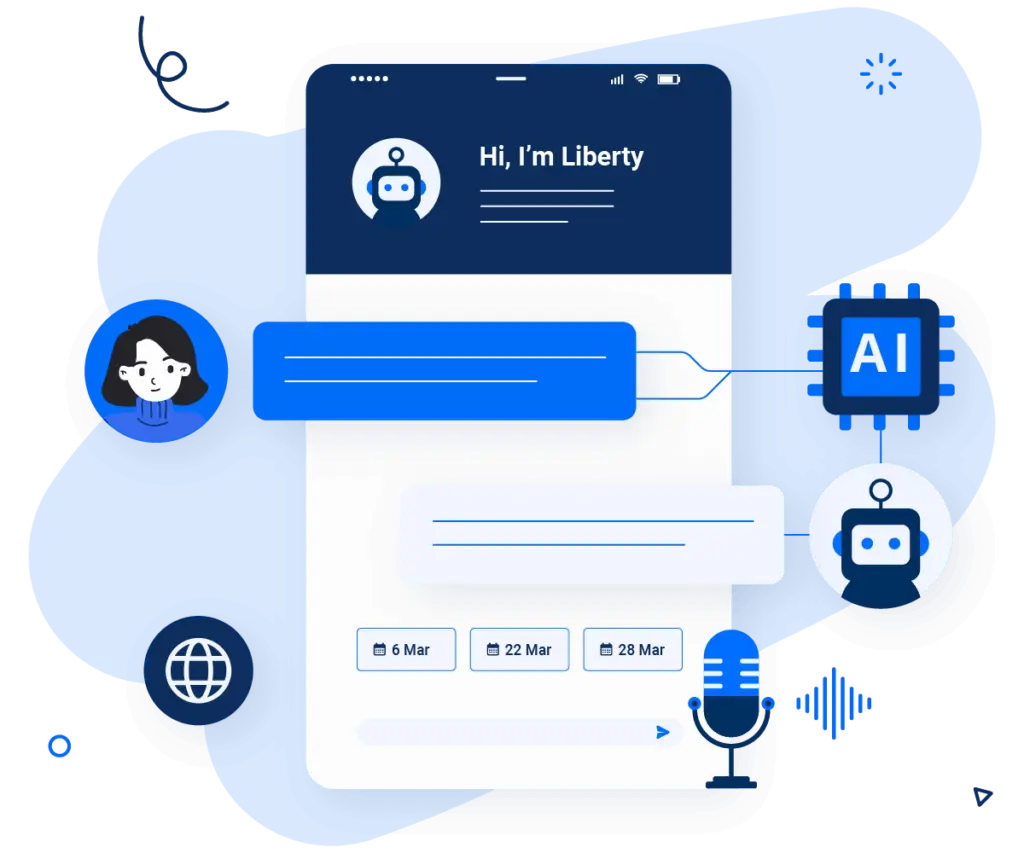
With Conversational AI, businesses can provide instant support to their customers without the need for human intervention. These chatbots can handle customer queries, provide product recommendations, and even complete transactions. This technology has become increasingly popular in customer service, as it reduces response time and improves customer satisfaction. Conversational AI is also present in the healthcare industry, where chatbots can assist patients with medical advice, provide information about medication, and even schedule appointments. It also helps education sector, where chatbots can help students with homework or provide learning resources.
The future of Conversational AI is bright, with advancements in natural language processing and machine learning. As technology continues to improve, we can expect to see more sophisticated chatbots that can handle complex tasks and communicate more effectively with humans. Businesses that adopt this technology can provide better customer experiences and stay ahead of the competition.
Historical Background of Conversational AI
Early Chatbots
The history of Conversational AI dates back to the 1960s when the first chatbot, ELIZA, was developed. ELIZA was a natural language processing program that mimicked a Rogerian psychotherapist by responding to the user’s input with questions. It was created by MIT professor Joseph Weizenbaum and became popular for its ability to hold conversations that felt almost human-like. In the following decades, various chatbots were developed, including PARRY, which simulated a patient with paranoid schizophrenia, and ALICE, designed to be a conversational agent for general communication.

With the advent of the internet and mobile devices, chatbots became more accessible, and their use cases expanded.
Voice Assistants
While early chatbots like ELIZA and ALICE paved the way for Conversational AI, the real breakthrough came with introduction of voice assistants. Like Siri and Alexa, voice assistants use natural language processing and speech recognition to understand and respond to user requests.

The first voice assistant was developed by IBM in the early 2000s, but with the introduction of Siri on the iPhone in 2011, the technology gained widespread popularity. Since then, voice assistants have become an integral part of our daily lives, with millions of people using them to set reminders, play music, and order groceries. The popularity of voice assistants has also led to their integration into other devices, like smart speakers and home automation systems. As the technology continues to improve, we can expect voice assistants to become even more sophisticated and capable, further expanding their use cases in various industries.
Natural Language Processing (NLP) and Speech Recognition
Natural Language Processing (NLP) and Speech Recognition are the two key technologies that power Conversational AI. NLP enables computers to understand and interpret human language, while speech recognition allows them to recognize and transcribe spoken language. The history of NLP dates back to the 1950s when computer scientists began developing algorithms to analyze and understand natural language.
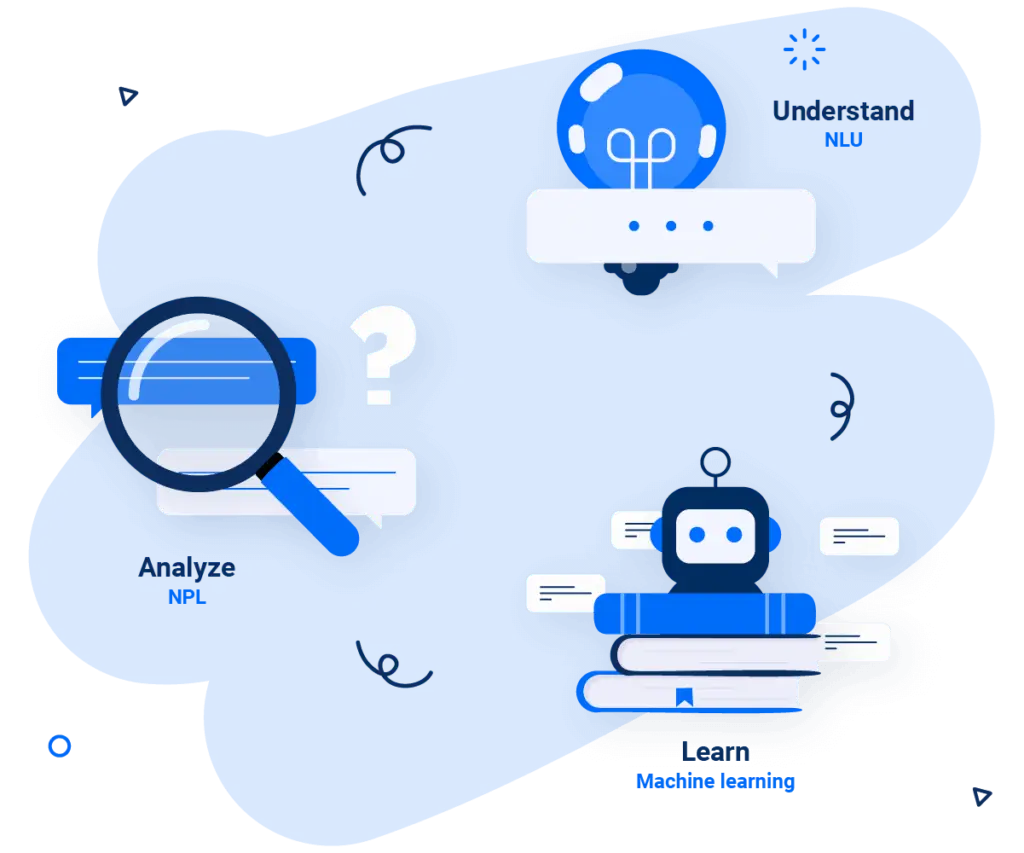
Over the years, advancements in machine learning and deep learning have led to significant improvements in NLP, allowing computers to understand and respond to natural language with increasing accuracy. Speech recognition technology has also undergone significant development over the years. Early speech recognition systems relied on simple acoustic models and limited vocabulary, but today’s systems can recognize speech with high accuracy, even in noisy environments.
Together, NLP and speech recognition have paved the way for Conversational AI. They enable computers to communicate with humans in a natural and intuitive way. As these technologies continue to improve, we can expect to see more sophisticated and capable Conversational AI systems that can handle complex tasks and provide even more personalized experiences.
The Intersection of NLP and Speech Recognition
The intersection of Natural Language Processing (NLP) and Speech Recognition has revolutionized the field of Conversational AI. NLP enables computers to understand and interpret human language, while speech recognition allows them to recognize and transcribe spoken language. Together, these technologies make it possible for humans to interact with computers in a natural and intuitive way.
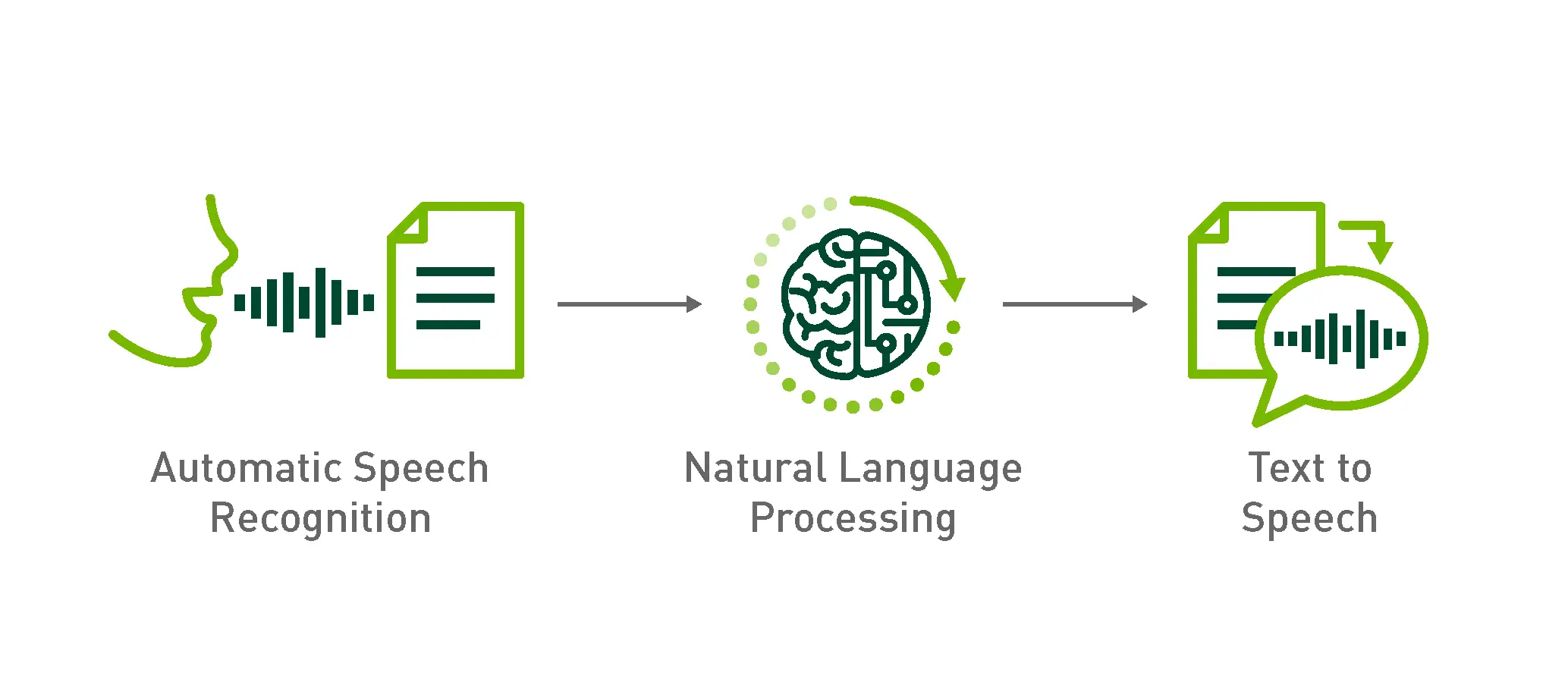
According to a report by MarketsandMarkets, the global market for Conversational AI is expected to grow from $4.2 billion in 2019 to $15.7 billion by 2024, with NLP and speech recognition being the key drivers of this growth. The intersection of NLP and speech recognition has also led to the development of intelligent virtual assistants like Siri and Alexa, which have become increasingly popular in recent years.
According to a report by Voicebot.ai, the number of smart speaker users in the United States is expected to reach 100 million by 2025. Furthermore, the COVID-19 pandemic has accelerated the adoption of Conversational AI, with businesses using chatbots and virtual assistants to provide customer support and automate tasks. According to a report by Grand View Research, the global chatbot market is expected to reach $9.4 billion by 2024.
Recent Advancements in Conversational AI
OpenAI’s GPT-3 & GPT-4
One of the most significant recent advancements in Conversational AI is OpenAI’s GPT-3 (Generative Pre-trained Transformer 3) language model. GPT-3 is an autoregressive language model that uses deep learning to generate human-like responses to text-based prompts. GPT-3 has been hailed as a major breakthrough in Conversational AI, with its ability to generate coherent and contextually relevant responses. According to OpenAI, GPT-3 is capable of performing a wide range of language tasks, including language translation, summarization, and question-answering.
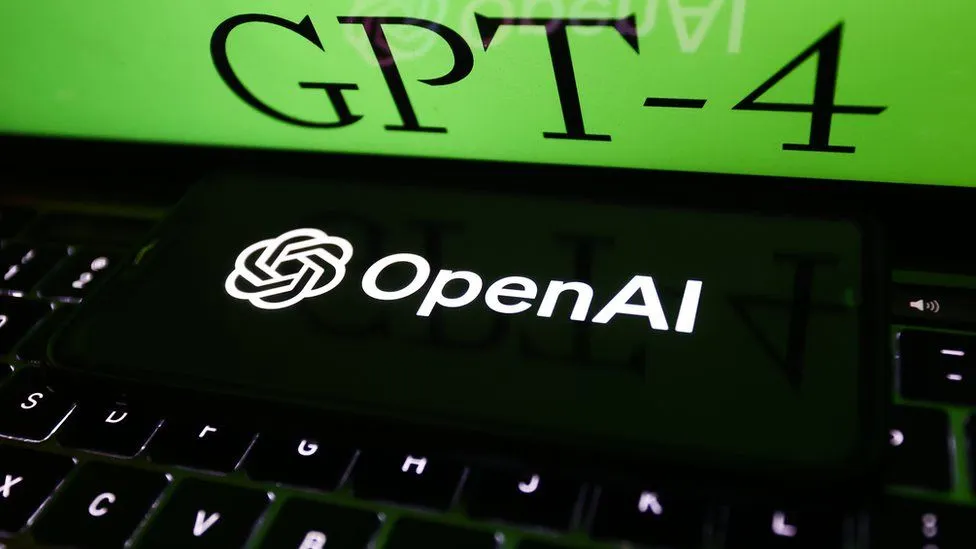
In addition to GPT-3, OpenAI has also announced its plans for GPT-4, which is expected to be even more powerful and capable than its predecessor. According to OpenAI, GPT-4 will be able to generate more complex and nuanced language and will be capable of performing even more advanced language tasks.
The potential applications of GPT-3 and GPT-4 are vast, with implications for industries ranging from healthcare to education to customer service. For example, GPT-3 could be used to develop virtual assistants that can provide personalized healthcare recommendations or to create intelligent tutoring systems that can adapt to individual learning styles.
Google’s BERT
Google’s Bidirectional Encoder Representations from Transformers (BERT) is another recent advancement in Conversational AI. BERT is a language model that uses deep learning techniques to understand the context and meaning of words within a sentence.
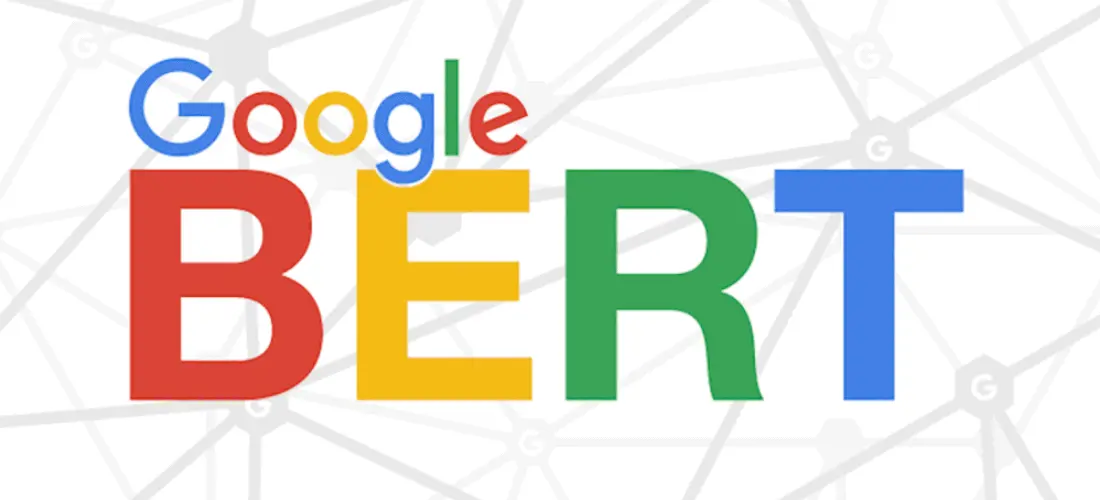
Google’s BERT is not just any ordinary language model. It’s a game-changer that uses advanced deep-learning techniques to understand language context and deliver more accurate results. BERT has made remarkable contributions to natural language processing, text classification, and question-answering. In fact, Google has reported that BERT has improved its search algorithm, enabling it to understand user intent better and provide more relevant results.
But BERT’s applications extend far beyond search. It has the potential to revolutionize various industries, from healthcare to finance. For instance, BERT can analyze medical records and support doctors’ diagnoses and treatment decisions. The impact of BERT on Conversational AI is undeniable. With its ability to comprehend the nuances of language, BERT paves the way for more effective communication between humans and machines. It’s a significant leap forward in natural language processing that opens up possibilities for improved user experiences and enhanced productivity.
Microsoft’s Turing Natural Language Generation

Microsoft’s Turing Natural Language Generation (T-NLG) is a state-of-the-art conversational AI model that uses advanced deep learning techniques to generate human-like responses to queries. T-NLG has set new benchmarks for natural language processing with impressive performance metrics. According to Microsoft, T-NLG has achieved a score of 91.8 on the BLEU-4 metric, which measures the quality of the machine-generated text. This is a significant improvement over its predecessor, GPT-2, which achieved a score of 76.1.
With its exceptional performance, T-NLG has the potential to revolutionize many industries, from customer service to content creation. For example, T-NLG can generate personalized responses to customer queries, providing a more engaging and interactive customer experience. Microsoft’s T-NLG is a significant advancement in Conversational AI that can potentially transform how we communicate with machines. Its exceptional performance and wide range of applications make it a powerful tool for businesses and individuals alike, paving the way for a more efficient and effective future.
Real-World Applications of Conversational AI
Healthcare
Conversational AI has numerous applications in the healthcare industry, including virtual assistants, medical chatbots, and patient monitoring systems.
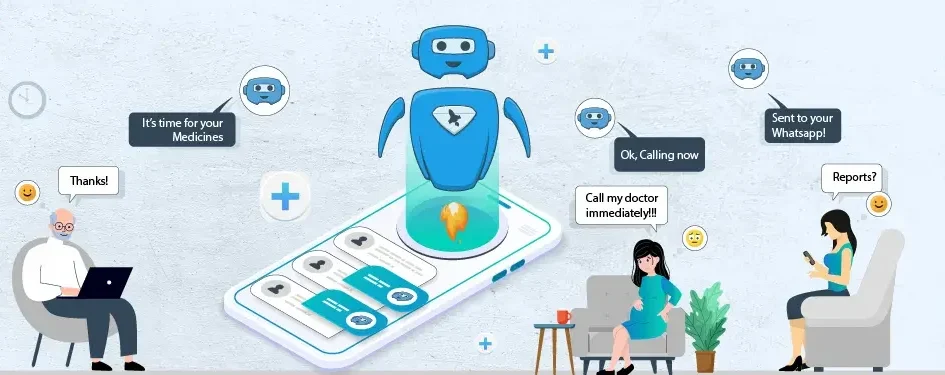
According to a report by Grand View Research, the global conversational AI market in healthcare is expected to reach $3.7 billion by 2025, with a compound annual growth rate of 34.5%. Virtual assistants powered by conversational AI can help healthcare providers streamline patient appointments and reduce wait times.
Medical chatbots can provide patients with personalized support and guidance, including symptom checking, medication reminders, and mental health support. Conversational AI can also monitor patients remotely, helping detect potential health issues and intervene before they become serious. This can be particularly useful for elderly or chronically ill patients who require frequent monitoring and support.
Customer Service
Conversational AI has transformed the customer service industry by providing 24/7 customer support with faster response times, reducing the workload of customer service representatives.
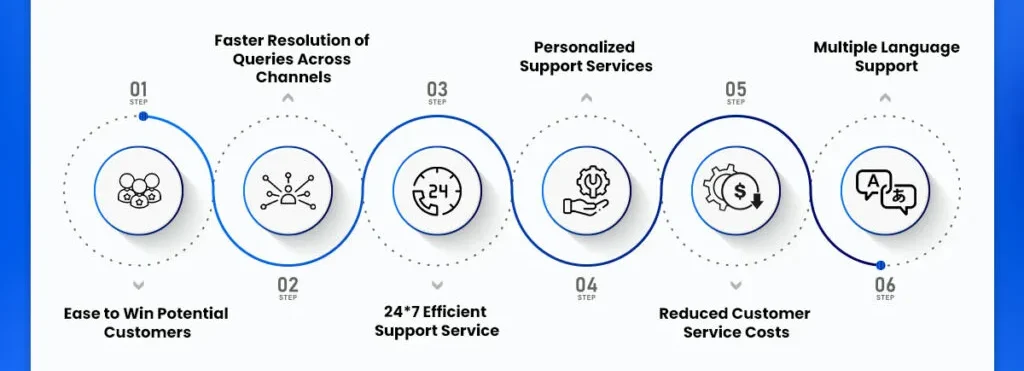
Chatbots and virtual assistants powered by conversational AI can handle basic customer queries, provide product recommendations, and even process orders. They can also collect feedback and customer data, helping businesses improve their products and services. Conversational AI can also enhance the customer experience by providing recommendations and advertising based on customer preferences. This can lead to increased customer satisfaction and loyalty.
Conversational AI is revolutionizing the customer service industry, providing faster, more efficient, and personalized support to customers around the clock.
Education
Conversational AI has found its place in education as a tool that improves student engagement and learning experiences. The use of chatbots in the education sector is increasing. They are capable of answering student queries, provide feedback on assignments, and suggest learning resources. According to a report by Technavio, the global chatbot market in the education sector is expected to grow by USD 244.5 million between 2021-2025 at a CAGR of 29%. Chatbots assist students and automate administrative tasks, including enrollment, registration, and payment processing.
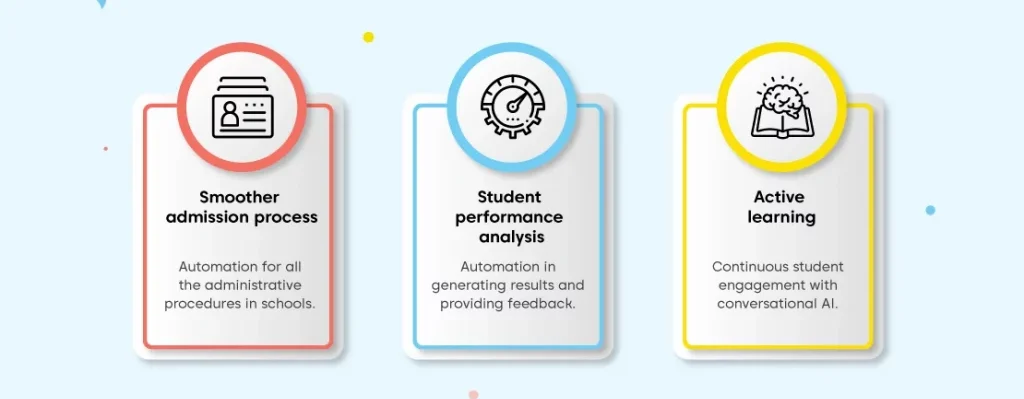
An example of Conversational AI in education is the University of Georgia’s chatbot, “Pounce” which has successfully answered over 200,000 student queries per semester. The chatbot is designed to provide a personalized experience for each student, which has resulted in increased student satisfaction. Another example of Conversational AI in education is AI-powered language learning chatbots such as Duolingo and Babbel. These chatbots offer a personalized language learning experience tailored to the student’s learning style and pace.
Business
Conversational AI is becoming increasingly popular in the business sector, as it has the potential to enhance customer experience and improve operational efficiency. Chatbots and virtual assistants are two examples of AI-powered technologies. Companies use them to handle routine customer queries, provide personalized recommendations, and reduce the workload on customer service teams.
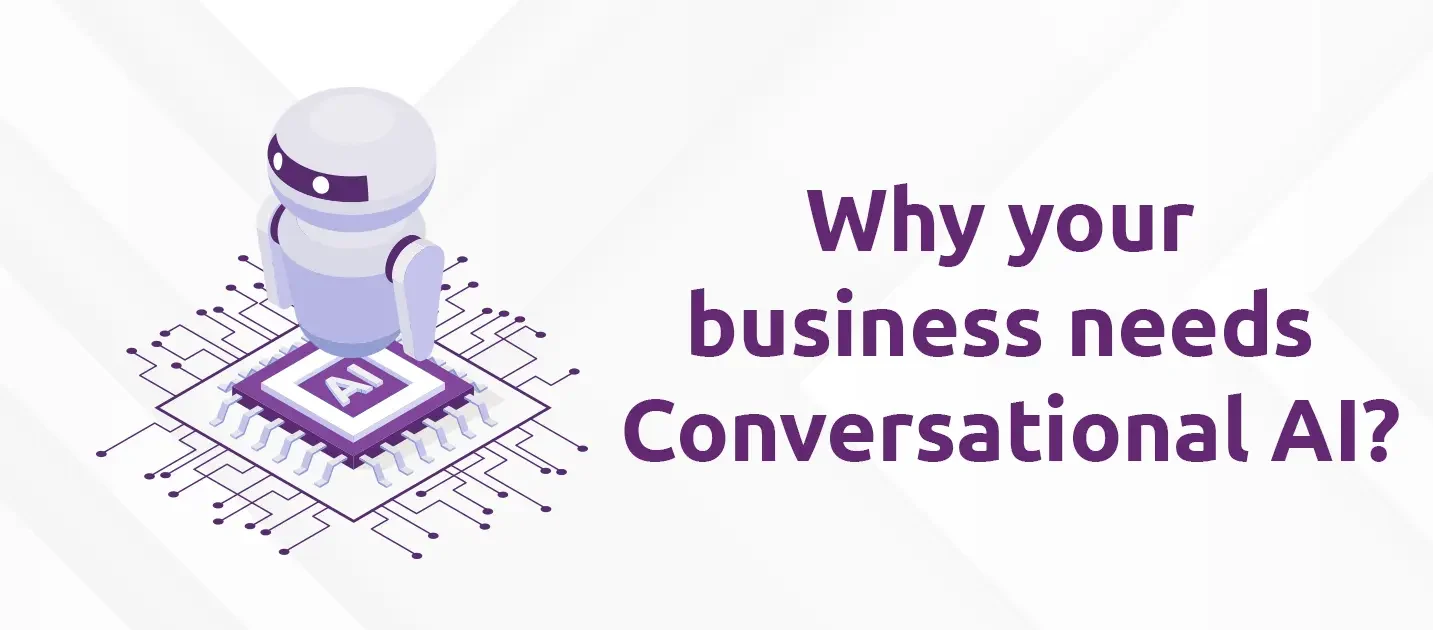
One of the examples of Conversational AI in business is the use of chatbots by Sephora to help customers find and purchase products. Sephora’s chatbot assists customers in choosing the right products based on their skin type, color preferences, and desired results. Another example of using Conversational AI in business is virtual assistants in the insurance industry. Insurers such as Geico and Allstate use virtual assistants to provide customers with policy information, process claims, and answer frequently asked questions.
Another example is using virtual assistants by financial institutions like Bank of America to provide customers with personalized financial advice and transaction assistance.
Conversational AI has the potential to transform the way businesses interact with customers, improving the customer experience and reducing operational costs.
The Future of Conversational AI and Human Interaction
Human-Machine Interaction
The future of conversational AI and human interaction comes with the emergence of a new paradigm called Human-Machine Interaction (HMI). HMI is a collaborative effort between humans and machines to create a more natural, intuitive, and efficient communication method. It seeks to enhance the human experience by blending the strengths of humans and machines. It results in a more seamless and effective interaction. Conversational AI technology is advancing incredibly, driven by the need for more personalized and efficient communication in our daily lives. Conversational AI is becoming more ubiquitous with the rise of voice-activated devices, chatbots, and virtual assistants.

HMI becomes even more sophisticated by integrating machine learning, natural language processing, and computer vision. This will enable machines better to understand human emotions, intentions, and behavior and respond more personalized and empathetically. Additionally, HMI will lead to the development of new technologies that will enhance our daily lives, such as smart homes, autonomous vehicles, and intelligent personal assistants. Despite the rapid advancements in conversational AI, concerns about the potential negative impact on human jobs and privacy remain. As such, it is essential to approach HMI cautiously and ensure that it is only available to benefit humanity as a whole rather than just a select few.
The future of conversational AI and human interaction is bright, with HMI capable of revolutionizing how we communicate and interact with technology. It is an exciting time for the field of AI, and the potential applications of HMI are vast and varied. As we move forward, we must consider these technologies’ ethical and social implications and ensure that they will help us with the greater good in mind.
Augmented Intelligence
The future of conversational AI and human interaction is bright, with Augmented Intelligence (AI) leading the way. Unlike traditional AI, which aims to replace human intelligence, augmented intelligence enhances human intelligence with advanced technologies such as machine learning, natural language processing, and computer vision. Augmented intelligence offers exciting possibilities for improving human potential in working, learning, and interacting with machines. With the growing prevalence of smart assistants, chatbots, and other conversational AI technologies, augmented intelligence is becoming more pervasive than ever before.

Augmented intelligence will become even more sophisticated by integrating emerging technologies like augmented reality and virtual reality. These advancements will allow machines to understand human needs and preferences better and provide more personalized recommendations and solutions.
The Future of Work and Conversational AI
Conversational AI is transforming the way we work, and the future looks even more promising.
One of the key benefits is its ability to automate repetitive tasks. It results in freeing up valuable time and resources for more complex and creative work. For example, chatbots and virtual assistants can handle customer service inquiries and support tasks, while intelligent automation systems can streamline workflows and reduce manual data entry. In addition, it can provide valuable insights and analysis to help us make better business decisions.
Conversation AI can provide real-time actionable insights and recommendations by analyzing data from multiple sources. As conversational AI technology continues to evolve, it is essential that we invest in workforce training and development. It helps to ensure that employees are aware of the necessary skills to work effectively with these powerful tools. The future of work and conversational AI looks bright, and we expect continued innovation and growth in this exciting field.
The Impact of Conversational AI on Society
Conversational AI, or artificial intelligence designed to interact with humans in natural language, has grown rapidly in popularity and sophistication in recent years. While conversational AI offers many benefits, such as improving efficiency and accessibility, it also has a significant impact on society, both positive and negative.
Here are some points to consider:
- Improved Customer Service: Conversational AI has revolutionized customer service. Chatbots, for example, can handle basic customer queries and complaints, freeing up human customer service representatives for more complex issues.
- Increased Accessibility: Conversational AI has made technology more accessible to people with disabilities, such as visual or motor impairments, who may struggle with traditional interfaces. Voice assistants, for instance, can make it easier for people with limited mobility to control their smart home devices.
- Privacy Concerns: Conversational AI relies on collecting data about users in order to improve its responses. However, this raises concerns about data privacy and security, as companies may collect sensitive personal information without user consent.
- Job Displacement: As conversational AI becomes more advanced, it may replace human workers in certain industries, such as customer service or data entry. While this may increase efficiency and cost savings for companies, it could also lead to job loss for many people.
- Ethical Considerations: Conversational AI raises ethical questions about how it is used. For example, some people have raised concerns about using chatbots in healthcare. They arugue that they cannot provide the same level of empathy and the human connection necessary for effective healthcare.
- Bias: Conversational AI is only as unbiased as the data it is trained on. On bias data, the AI generates bias output. This can lead to perpetuating harmful stereotypes and discrimination.
Final Words
Conversational AI is a game-changer in technology, offering endless possibilities for businesses and individuals alike. It can facilitate more natural and intuitive interactions between humans and machines by leveraging natural language processing, machine learning, and other advanced technologies. This can lead to a better user experience, improved customer service, and greater efficiency in many industries. From chatbots to voice assistants, Conversation AI is transforming how we interact with technology. It is making our lives easier and more convenient. As this technology continues to evolve and improve, we can expect even more exciting developments in the near future.
Tagged
Share This Article
Have you ever chatted with a robot? If so, chances are you were interacting with conversational AI. This exciting technology is becoming more prevalent in our daily lives, as businesses and organizations use it to improve customer engagement, streamline operations, and provide better service.
This article will delve into the history of Conversational AI, from early chatbots to modern voice assistants. We will explore the technology behind it, including Natural Language Processing (NLP) and Speech Recognition. Moreover, we will discuss the recent advancements in Conversational AI, such as OpenAI’s GPT-3 and the latest version GPT-4, Google’s BERT, and Microsoft’s Turing Natural Language Generation. We will also examine its real-world applications, from healthcare and customer service to education and business. Finally, we will speculate on the future of Conversational AI and its impact on human-machine interaction, augmented intelligence, and the workforce.
After reading this article, you will have a comprehensive understanding of Conversational AI and its potential to shape the future of technology.
Let’s begin!
Conversational AI
Conversational AI is the technology that enables computers to communicate with humans in a natural language. It is also known as chatbots, virtual assistants, or voice assistants. Conversational AI can understand human language, interpret it, and respond like humans. This technology is revolutionizing how businesses interact with customers, making communication more efficient and effective.

With Conversational AI, businesses can provide instant support to their customers without the need for human intervention. These chatbots can handle customer queries, provide product recommendations, and even complete transactions. This technology has become increasingly popular in customer service, as it reduces response time and improves customer satisfaction. Conversational AI is also present in the healthcare industry, where chatbots can assist patients with medical advice, provide information about medication, and even schedule appointments. It also helps education sector, where chatbots can help students with homework or provide learning resources.
The future of Conversational AI is bright, with advancements in natural language processing and machine learning. As technology continues to improve, we can expect to see more sophisticated chatbots that can handle complex tasks and communicate more effectively with humans. Businesses that adopt this technology can provide better customer experiences and stay ahead of the competition.
Historical Background of Conversational AI
Early Chatbots
The history of Conversational AI dates back to the 1960s when the first chatbot, ELIZA, was developed. ELIZA was a natural language processing program that mimicked a Rogerian psychotherapist by responding to the user’s input with questions. It was created by MIT professor Joseph Weizenbaum and became popular for its ability to hold conversations that felt almost human-like. In the following decades, various chatbots were developed, including PARRY, which simulated a patient with paranoid schizophrenia, and ALICE, designed to be a conversational agent for general communication.

With the advent of the internet and mobile devices, chatbots became more accessible, and their use cases expanded.
Voice Assistants
While early chatbots like ELIZA and ALICE paved the way for Conversational AI, the real breakthrough came with introduction of voice assistants. Like Siri and Alexa, voice assistants use natural language processing and speech recognition to understand and respond to user requests.

The first voice assistant was developed by IBM in the early 2000s, but with the introduction of Siri on the iPhone in 2011, the technology gained widespread popularity. Since then, voice assistants have become an integral part of our daily lives, with millions of people using them to set reminders, play music, and order groceries. The popularity of voice assistants has also led to their integration into other devices, like smart speakers and home automation systems. As the technology continues to improve, we can expect voice assistants to become even more sophisticated and capable, further expanding their use cases in various industries.
Natural Language Processing (NLP) and Speech Recognition
Natural Language Processing (NLP) and Speech Recognition are the two key technologies that power Conversational AI. NLP enables computers to understand and interpret human language, while speech recognition allows them to recognize and transcribe spoken language. The history of NLP dates back to the 1950s when computer scientists began developing algorithms to analyze and understand natural language.

Over the years, advancements in machine learning and deep learning have led to significant improvements in NLP, allowing computers to understand and respond to natural language with increasing accuracy. Speech recognition technology has also undergone significant development over the years. Early speech recognition systems relied on simple acoustic models and limited vocabulary, but today’s systems can recognize speech with high accuracy, even in noisy environments.
Together, NLP and speech recognition have paved the way for Conversational AI. They enable computers to communicate with humans in a natural and intuitive way. As these technologies continue to improve, we can expect to see more sophisticated and capable Conversational AI systems that can handle complex tasks and provide even more personalized experiences.
The Intersection of NLP and Speech Recognition
The intersection of Natural Language Processing (NLP) and Speech Recognition has revolutionized the field of Conversational AI. NLP enables computers to understand and interpret human language, while speech recognition allows them to recognize and transcribe spoken language. Together, these technologies make it possible for humans to interact with computers in a natural and intuitive way.

According to a report by MarketsandMarkets, the global market for Conversational AI is expected to grow from $4.2 billion in 2019 to $15.7 billion by 2024, with NLP and speech recognition being the key drivers of this growth. The intersection of NLP and speech recognition has also led to the development of intelligent virtual assistants like Siri and Alexa, which have become increasingly popular in recent years.
According to a report by Voicebot.ai, the number of smart speaker users in the United States is expected to reach 100 million by 2025. Furthermore, the COVID-19 pandemic has accelerated the adoption of Conversational AI, with businesses using chatbots and virtual assistants to provide customer support and automate tasks. According to a report by Grand View Research, the global chatbot market is expected to reach $9.4 billion by 2024.
Recent Advancements in Conversational AI
OpenAI’s GPT-3 & GPT-4
One of the most significant recent advancements in Conversational AI is OpenAI’s GPT-3 (Generative Pre-trained Transformer 3) language model. GPT-3 is an autoregressive language model that uses deep learning to generate human-like responses to text-based prompts. GPT-3 has been hailed as a major breakthrough in Conversational AI, with its ability to generate coherent and contextually relevant responses. According to OpenAI, GPT-3 is capable of performing a wide range of language tasks, including language translation, summarization, and question-answering.

In addition to GPT-3, OpenAI has also announced its plans for GPT-4, which is expected to be even more powerful and capable than its predecessor. According to OpenAI, GPT-4 will be able to generate more complex and nuanced language and will be capable of performing even more advanced language tasks.
The potential applications of GPT-3 and GPT-4 are vast, with implications for industries ranging from healthcare to education to customer service. For example, GPT-3 could be used to develop virtual assistants that can provide personalized healthcare recommendations or to create intelligent tutoring systems that can adapt to individual learning styles.
Google’s BERT
Google’s Bidirectional Encoder Representations from Transformers (BERT) is another recent advancement in Conversational AI. BERT is a language model that uses deep learning techniques to understand the context and meaning of words within a sentence.

Google’s BERT is not just any ordinary language model. It’s a game-changer that uses advanced deep-learning techniques to understand language context and deliver more accurate results. BERT has made remarkable contributions to natural language processing, text classification, and question-answering. In fact, Google has reported that BERT has improved its search algorithm, enabling it to understand user intent better and provide more relevant results.
But BERT’s applications extend far beyond search. It has the potential to revolutionize various industries, from healthcare to finance. For instance, BERT can analyze medical records and support doctors’ diagnoses and treatment decisions. The impact of BERT on Conversational AI is undeniable. With its ability to comprehend the nuances of language, BERT paves the way for more effective communication between humans and machines. It’s a significant leap forward in natural language processing that opens up possibilities for improved user experiences and enhanced productivity.
Microsoft’s Turing Natural Language Generation

Microsoft’s Turing Natural Language Generation (T-NLG) is a state-of-the-art conversational AI model that uses advanced deep learning techniques to generate human-like responses to queries. T-NLG has set new benchmarks for natural language processing with impressive performance metrics. According to Microsoft, T-NLG has achieved a score of 91.8 on the BLEU-4 metric, which measures the quality of the machine-generated text. This is a significant improvement over its predecessor, GPT-2, which achieved a score of 76.1.
With its exceptional performance, T-NLG has the potential to revolutionize many industries, from customer service to content creation. For example, T-NLG can generate personalized responses to customer queries, providing a more engaging and interactive customer experience. Microsoft’s T-NLG is a significant advancement in Conversational AI that can potentially transform how we communicate with machines. Its exceptional performance and wide range of applications make it a powerful tool for businesses and individuals alike, paving the way for a more efficient and effective future.
Real-World Applications of Conversational AI
Healthcare
Conversational AI has numerous applications in the healthcare industry, including virtual assistants, medical chatbots, and patient monitoring systems.

According to a report by Grand View Research, the global conversational AI market in healthcare is expected to reach $3.7 billion by 2025, with a compound annual growth rate of 34.5%. Virtual assistants powered by conversational AI can help healthcare providers streamline patient appointments and reduce wait times.
Medical chatbots can provide patients with personalized support and guidance, including symptom checking, medication reminders, and mental health support. Conversational AI can also monitor patients remotely, helping detect potential health issues and intervene before they become serious. This can be particularly useful for elderly or chronically ill patients who require frequent monitoring and support.
Customer Service
Conversational AI has transformed the customer service industry by providing 24/7 customer support with faster response times, reducing the workload of customer service representatives.

Chatbots and virtual assistants powered by conversational AI can handle basic customer queries, provide product recommendations, and even process orders. They can also collect feedback and customer data, helping businesses improve their products and services. Conversational AI can also enhance the customer experience by providing recommendations and advertising based on customer preferences. This can lead to increased customer satisfaction and loyalty.
Conversational AI is revolutionizing the customer service industry, providing faster, more efficient, and personalized support to customers around the clock.
Education
Conversational AI has found its place in education as a tool that improves student engagement and learning experiences. The use of chatbots in the education sector is increasing. They are capable of answering student queries, provide feedback on assignments, and suggest learning resources. According to a report by Technavio, the global chatbot market in the education sector is expected to grow by USD 244.5 million between 2021-2025 at a CAGR of 29%. Chatbots assist students and automate administrative tasks, including enrollment, registration, and payment processing.

An example of Conversational AI in education is the University of Georgia’s chatbot, “Pounce” which has successfully answered over 200,000 student queries per semester. The chatbot is designed to provide a personalized experience for each student, which has resulted in increased student satisfaction. Another example of Conversational AI in education is AI-powered language learning chatbots such as Duolingo and Babbel. These chatbots offer a personalized language learning experience tailored to the student’s learning style and pace.
Business
Conversational AI is becoming increasingly popular in the business sector, as it has the potential to enhance customer experience and improve operational efficiency. Chatbots and virtual assistants are two examples of AI-powered technologies. Companies use them to handle routine customer queries, provide personalized recommendations, and reduce the workload on customer service teams.

One of the examples of Conversational AI in business is the use of chatbots by Sephora to help customers find and purchase products. Sephora’s chatbot assists customers in choosing the right products based on their skin type, color preferences, and desired results. Another example of using Conversational AI in business is virtual assistants in the insurance industry. Insurers such as Geico and Allstate use virtual assistants to provide customers with policy information, process claims, and answer frequently asked questions.
Another example is using virtual assistants by financial institutions like Bank of America to provide customers with personalized financial advice and transaction assistance.
Conversational AI has the potential to transform the way businesses interact with customers, improving the customer experience and reducing operational costs.
The Future of Conversational AI and Human Interaction
Human-Machine Interaction
The future of conversational AI and human interaction comes with the emergence of a new paradigm called Human-Machine Interaction (HMI). HMI is a collaborative effort between humans and machines to create a more natural, intuitive, and efficient communication method. It seeks to enhance the human experience by blending the strengths of humans and machines. It results in a more seamless and effective interaction. Conversational AI technology is advancing incredibly, driven by the need for more personalized and efficient communication in our daily lives. Conversational AI is becoming more ubiquitous with the rise of voice-activated devices, chatbots, and virtual assistants.

HMI becomes even more sophisticated by integrating machine learning, natural language processing, and computer vision. This will enable machines better to understand human emotions, intentions, and behavior and respond more personalized and empathetically. Additionally, HMI will lead to the development of new technologies that will enhance our daily lives, such as smart homes, autonomous vehicles, and intelligent personal assistants. Despite the rapid advancements in conversational AI, concerns about the potential negative impact on human jobs and privacy remain. As such, it is essential to approach HMI cautiously and ensure that it is only available to benefit humanity as a whole rather than just a select few.
The future of conversational AI and human interaction is bright, with HMI capable of revolutionizing how we communicate and interact with technology. It is an exciting time for the field of AI, and the potential applications of HMI are vast and varied. As we move forward, we must consider these technologies’ ethical and social implications and ensure that they will help us with the greater good in mind.
Augmented Intelligence
The future of conversational AI and human interaction is bright, with Augmented Intelligence (AI) leading the way. Unlike traditional AI, which aims to replace human intelligence, augmented intelligence enhances human intelligence with advanced technologies such as machine learning, natural language processing, and computer vision. Augmented intelligence offers exciting possibilities for improving human potential in working, learning, and interacting with machines. With the growing prevalence of smart assistants, chatbots, and other conversational AI technologies, augmented intelligence is becoming more pervasive than ever before.

Augmented intelligence will become even more sophisticated by integrating emerging technologies like augmented reality and virtual reality. These advancements will allow machines to understand human needs and preferences better and provide more personalized recommendations and solutions.
The Future of Work and Conversational AI
Conversational AI is transforming the way we work, and the future looks even more promising.
One of the key benefits is its ability to automate repetitive tasks. It results in freeing up valuable time and resources for more complex and creative work. For example, chatbots and virtual assistants can handle customer service inquiries and support tasks, while intelligent automation systems can streamline workflows and reduce manual data entry. In addition, it can provide valuable insights and analysis to help us make better business decisions.
Conversation AI can provide real-time actionable insights and recommendations by analyzing data from multiple sources. As conversational AI technology continues to evolve, it is essential that we invest in workforce training and development. It helps to ensure that employees are aware of the necessary skills to work effectively with these powerful tools. The future of work and conversational AI looks bright, and we expect continued innovation and growth in this exciting field.
The Impact of Conversational AI on Society
Conversational AI, or artificial intelligence designed to interact with humans in natural language, has grown rapidly in popularity and sophistication in recent years. While conversational AI offers many benefits, such as improving efficiency and accessibility, it also has a significant impact on society, both positive and negative.
Here are some points to consider:
- Improved Customer Service: Conversational AI has revolutionized customer service. Chatbots, for example, can handle basic customer queries and complaints, freeing up human customer service representatives for more complex issues.
- Increased Accessibility: Conversational AI has made technology more accessible to people with disabilities, such as visual or motor impairments, who may struggle with traditional interfaces. Voice assistants, for instance, can make it easier for people with limited mobility to control their smart home devices.
- Privacy Concerns: Conversational AI relies on collecting data about users in order to improve its responses. However, this raises concerns about data privacy and security, as companies may collect sensitive personal information without user consent.
- Job Displacement: As conversational AI becomes more advanced, it may replace human workers in certain industries, such as customer service or data entry. While this may increase efficiency and cost savings for companies, it could also lead to job loss for many people.
- Ethical Considerations: Conversational AI raises ethical questions about how it is used. For example, some people have raised concerns about using chatbots in healthcare. They arugue that they cannot provide the same level of empathy and the human connection necessary for effective healthcare.
- Bias: Conversational AI is only as unbiased as the data it is trained on. On bias data, the AI generates bias output. This can lead to perpetuating harmful stereotypes and discrimination.
Final Words
Conversational AI is a game-changer in technology, offering endless possibilities for businesses and individuals alike. It can facilitate more natural and intuitive interactions between humans and machines by leveraging natural language processing, machine learning, and other advanced technologies. This can lead to a better user experience, improved customer service, and greater efficiency in many industries. From chatbots to voice assistants, Conversation AI is transforming how we interact with technology. It is making our lives easier and more convenient. As this technology continues to evolve and improve, we can expect even more exciting developments in the near future.




